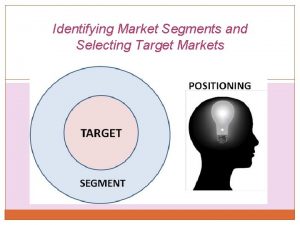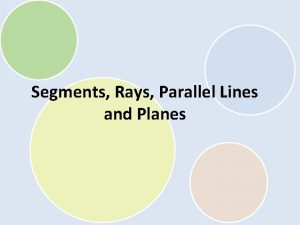CHAPTER 9 IDENTIFYING MARKET SEGMENTS AND SELECTING TARGET














- Slides: 14

CHAPTER 9 IDENTIFYING MARKET SEGMENTS AND SELECTING TARGET MARKETS

IMPORTANT TOPICS OF THIS CHAPTER Elements of market segmentations n Different levels of market segmentation n Segmentation procedure n Segmentation in consumer market n Segmentation in business market n Requirements for effective segmentation n Market targetting n

MARKET SEGMENTATION Market Segmentation Identify segment Develop profiles Market Targeting Market Positioning Evaluate Positioning Select Communicate

MARKET SEGMENTATION n Levels of Segmentation: » Mass Marketing: n » Segment Marketing: n » Narrowly defined market Local Marketing: n » Identifiable segment Niche Marketing: n » Mass production, mass distribution and mass promotion Satisfy needs of local customers Individual Marketing: n Customized or one-to-one marketing

MARKET SEGMENTATION (CONT. ) n Patterns of Segmentation: » Homogeneous: n » Diffused: n » Similar preferences: no clear segment No clear preferences : scattered around Clustered: n Distinct preferences: concentrated market

MARKET SEGMENTATION (CONT. ) n Segmentation Procedures: » Survey stage: n » Analysis stage: n » Exploratory: – Focus group interviews. Multivariate techniques: – Cluster Analysis, Factor analysis. Profiling stage: n Description of the segment by age, income, education, hobbies, etc.

BASES FOR SEGMENTATION IN CONSUMER MARKETS n Segmentation by consumer characteristics: » Geographic: n » Demographic: n » Life style and personality Behavioral: n » Age and life cycle, gender, income, generation(baby boomers) and social class. Psychographics: n » East, West, North, Europe, Asia Occasions, benefits, usage rate and status, loyalty Multi-Attribute Segmentation (Geoclustering): n PRIZM cluster ( clustering by zip codes)

BASES OF SEGMENTING IN BUSINESS MARKETS n Micro Segmentation-firm bases: » » n Macro Segmentation-market bases: » » n Purchasing process/decision style Decision making style-participative/nonparticipative Location, size and number of employees Total market share in the industry Purchasing Process-first-time buyers, novice and sophisticates buyers.

SEGMENTATION IN BUSINESS MARKETS n Programmed buyers: » Routine purchase n Relationship buyers: » Knowledgeable about competition n Transaction buyers: » Price and service sensitive buyers n Bargain hunters: » Ready to switch to competition

SEGMENTATION IN BUSINESS MARKET (CONT. ) n First-time prospects: » Customers who have not purchased yet. n Novices: » Customers who are starting their relationships n Sophisticates: » Established customers

REQUIREMENTS FOR EFFECTIVE SEGMENTATION n Measurable: » Size and power must be measured. n Substantial: » Large enough to make profit. n Accessible: » Easily reached and served. n Differentiable: » Distinguishable and respond differently to different marketing mix. n Actionable: » Open to service.

MARKET TARGETING n Evaluating the Segments: » Overall attractiveness: n » n Size, growth and risk factor Suitable for company’s objectives and resources Selecting the Segments: » » Single segment concentration Selective specialization: n » Product specialization: n » Number of segments Consumer Vs government Market specialization: n Consumer Vs government

MARKET TARGETING (CONT. ) » Full market coverage (IBM, Coca Cola, GM, GE) n n Undifferentiated marketing: – standardization and mass production Differentiated marketing: – cost factor- production, manufacturing, administrative, inventory and promotion

ADDITIONAL CONSIDERATION n Ethical Choices of Market Target: » n Segment Interrelationships and Super-segments: » n Toothpaste Segment-by-Segment Invasion: » n Cigarettes, beer Toyota and Nissan Inter-segment Cooperation: » cooperation within the company
 Identifying market segments and targets chapter 9
Identifying market segments and targets chapter 9 Identifying market segments and targets chapter 9
Identifying market segments and targets chapter 9 Identifying market segments and targets chapter 9
Identifying market segments and targets chapter 9 Primary target market and secondary target market
Primary target market and secondary target market Five patterns of target market selection
Five patterns of target market selection Identifying market segments and targets
Identifying market segments and targets Single segment concentration
Single segment concentration Selecting text means selecting
Selecting text means selecting Project identification and selection process
Project identification and selection process Adjective
Adjective Non identifying adjective clauses examples
Non identifying adjective clauses examples Identifying and non identifying adjective clauses
Identifying and non identifying adjective clauses Targeting positioning segmentation
Targeting positioning segmentation Selecting investment in global market
Selecting investment in global market Selecting investment in global market
Selecting investment in global market

























